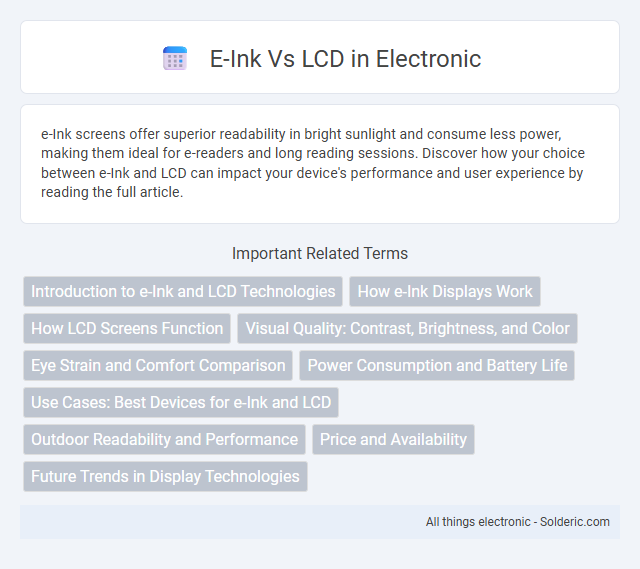e-Ink screens offer superior readability in bright sunlight and consume less power, making them ideal for e-readers and long reading sessions. Discover how your choice between e-Ink and LCD can impact your device's performance and user experience by reading the full article.
Comparison Table
| Feature | e-Ink Display | LCD Display |
|---|---|---|
| Technology | Electronic ink particles | Liquid crystal layers with backlight |
| Power Consumption | Very low, only uses power when updating screen | High, constant backlight usage |
| Readability | Excellent in direct sunlight, paper-like | Glare issues, less readable in sunlight |
| Refresh Rate | Slow, not suitable for videos | Fast, supports video and animations |
| Color Support | Limited color range (mostly grayscale, some color e-Ink) | Full color spectrum |
| Durability | Robust, less prone to screen burn | Susceptible to burn-in and damage |
| Applications | E-readers, low-power displays | Smartphones, TVs, monitors |
Introduction to e-Ink and LCD Technologies
e-Ink technology utilizes microcapsules filled with charged particles to create low-power, high-contrast displays ideal for e-readers, offering exceptional readability in direct sunlight. LCD screens rely on liquid crystal molecules manipulated by electric currents to modulate light from a backlight, enabling vibrant colors and fast refresh rates suitable for smartphones and computer monitors. Both display types diverge significantly in power consumption, visual performance, and typical applications within digital devices.
How e-Ink Displays Work
E-Ink displays function by arranging millions of microcapsules containing positively charged white particles and negatively charged black particles suspended in a clear fluid. When an electric field is applied, these particles move to the surface, creating visible text or images with high contrast and low power consumption. Your device benefits from this technology by offering readability comparable to printed paper, even in bright sunlight, while significantly extending battery life compared to traditional LCD screens.
How LCD Screens Function
LCD screens function by using a backlight that shines through liquid crystals arranged in pixels, which modulate light to create images based on electrical signals. These liquid crystals do not emit light themselves but control the passage of light to produce vibrant colors and sharp contrasts suitable for dynamic content like videos and gaming. The technology relies on precise manipulation of light polarization and color filters, resulting in high refresh rates and brightness levels necessary for multimedia applications.
Visual Quality: Contrast, Brightness, and Color
E-Ink displays offer superior contrast and readability in bright environments due to their reflective technology, which mimics ink on paper without backlight, resulting in less eye strain and excellent visibility under direct sunlight. LCD screens provide higher brightness and vibrant colors through backlighting, making them ideal for multimedia consumption but causing glare and fading visibility outdoors. While LCDs excel in dynamic color reproduction and brightness control, E-Ink remains unmatched for static text clarity and long-duration reading comfort.
Eye Strain and Comfort Comparison
E-Ink displays significantly reduce eye strain due to their reflective technology that mimics natural paper, making them ideal for extended reading sessions. In contrast, LCD screens emit blue light and flicker, which can cause discomfort and fatigue over prolonged use. Your choice of e-reader or device directly impacts eye comfort, especially if you spend hours reading or viewing content daily.
Power Consumption and Battery Life
e-Ink displays consume significantly less power than LCD screens because they only use energy when the content changes, enabling longer battery life for devices like e-readers. LCDs require continuous power to maintain backlighting and refresh the screen, leading to faster battery drain in smartphones and tablets. Choosing an e-Ink device can extend your battery life substantially, making it ideal for reading in environments where frequent charging isn't practical.
Use Cases: Best Devices for e-Ink and LCD
e-Ink displays excel in devices like e-readers (e.g., Amazon Kindle, Kobo Clara HD) due to their paper-like readability and low power consumption, making them ideal for prolonged reading in various lighting conditions. LCD screens dominate in smartphones, tablets (e.g., iPad, Samsung Galaxy Tab), and laptops, offering vibrant color reproduction and fast refresh rates suited for multimedia, gaming, and productivity tasks. For outdoor use and reading-intensive applications, e-Ink devices are preferred, whereas LCDs provide superior versatility for general-purpose computing and entertainment.
Outdoor Readability and Performance
E-Ink displays offer superior outdoor readability due to their reflective screen technology, which mimics paper and remains visible under direct sunlight without glare. LCD screens rely on backlighting that can cause significant glare and washout in bright conditions, reducing visibility outdoors. E-Ink's low power consumption and high contrast ratio ensure consistent performance during extended outdoor use, while LCDs often struggle with brightness adjustments and battery drain in such environments.
Price and Availability
E-Ink displays are generally more expensive than traditional LCD screens due to their specialized hardware and lower production volume, with prices typically ranging from $100 to $300 for e-readers compared to $50 to $150 for comparable LCD tablets. Availability of e-Ink devices is more limited, mainly found in niche markets like e-readers and digital signage, while LCD screens dominate mainstream electronics such as smartphones, monitors, and laptops because of their mass production and versatility. Retailers and manufacturers often stock a wide variety of LCD products in multiple sizes and resolutions, ensuring greater consumer access and competitive pricing.
Future Trends in Display Technologies
Future trends in display technologies emphasize e-Ink's advancements in color vibrancy and refresh rates, positioning it as ideal for low-power, high-readability devices like e-readers and smartwatches. LCD technology continues to evolve with higher resolution, faster response times, and improved energy efficiency, enhancing user experiences in smartphones, tablets, and monitors. Considering your needs for readability and battery life, e-Ink may become increasingly attractive for specialized applications, while LCD remains dominant for vibrant, fast-moving visuals.
e-Ink vs LCD Infographic

 solderic.com
solderic.com